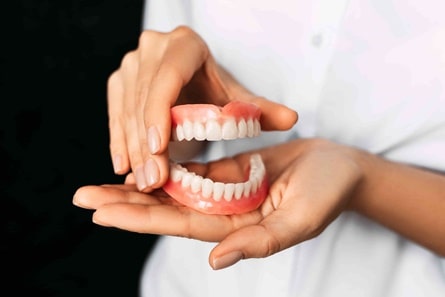If you have lost some (or all) of your natural teeth, denture can enhance (or restore) your appearance. It is also virtually undetectable. It will however, like any prosthetic appliance, take a little time to get used to. You can also expect a little gum soreness at first. Thus, for your comfort, you might need to return to the dentist a few times so adjustments can be made.
Eating with your dentures will entail some practice. It is best to begin eating soft foods first, making sure you can chew food equally on both sides of your mouth. You can slowly introduce more solid foods after. As soon as the tongue and cheeks get used to the denture, they will automatically help ensure the denture is kept in place.
Speaking while wearing your dentures will also require some practice in the beginning. Fortunately, it will get easy as you go along. Yawning, laughing, and other exaggerated movements may dislodge the denture at first. If so, you will need to visit your dentist for an adjustment.1
What are the different types of dentures?
Complete Dentures
Complete dentures have a coloured plastic base that replicates gum tissue. It supports a full set of plastic teeth. Dentures are held in place by either attaching them to dental implants, holding on to adjacent teeth or through forming a seal with the gums.
Partial Dentures
Partial dentures can be made of metal framework or plastic base that supports the number of teeth that needs replacement. It is held in the mouth through rests and clasps that are adapted around your natural teeth.
The metal framework is often the preferred option because of the metal’s strength and rigidity. Plastic dentures are typically used as temporary or emergency replacements until the bone and gums heal and a definitive restorative alternative is obtained. It really depends on your needs as well as what your dentist recommends for you.
Are there alternatives to dentures?
There are two other options available to replace missing teeth—implants and bridges.
Bridges
A bridge is a tooth replacement option in which teeth adjacent to an empty space are trimmed down in preparation for a crown. A replacement tooth is placed in the middle of the crowns to “bridge” over the space – hence the name. Bridges can be made of zirconium, gold, or porcelain. Depending on the location, bridges can replace two or three missing teeth in a row. Since they are cemented in place, bridges are considered a “permanent or fixed denture.”
Implants
A metal titanium screw that is inserted into the bone of either the lower or upper jaw is called a dental implant. A component, called abutment, is then screwed onto the implant and a crown is then attached to it. When multiple teeth need to be replaced, a bridge is used attached the multiple dental implants to form a long span biting surface.

If you have lost some (or all) of your natural teeth, denture can enhance (or restore) your appearance. It is also virtually undetectable. It will however, like any prosthetic appliance, take a little time to get used to. You can also expect a little gum soreness at first. Thus, for your comfort, you might need to return to the dentist a few times so adjustments can be made.
Eating with your dentures will entail some practice. It is best to begin eating soft foods first, making sure you can chew food equally on both sides of your mouth. You can slowly introduce more solid foods after. As soon as the tongue and cheeks get used to the denture, they will automatically help ensure the denture is kept in place.
Speaking while wearing your dentures will also require some practice in the beginning. Fortunately, it will get easy as you go along. Yawning, laughing, and other exaggerated movements may dislodge the denture at first. If so, you will need to visit your dentist for an adjustment.1
Frequently Asked Questions about Denture repairs
Do I need to wear my dentures throughout the day?
Generally, you can wear your dentures during the day and remove them at night to give your oral tissues some time to relax. However, during the first few days, it is advisable to not remove your dentures even during sleep so it’s easier to identify the areas where adjustment is needed.
How often should I see my dentist?
Do I need to use denture adhesive?
Denture adhesive is a glue or paste designed to help your denture adhere to the supporting tissues as opposed to merely relying on clasps.
To improve retention and stability, a small amount of denture cream may be applied to the denture. However, denture adhesives should not be used to compensate for poor-fitting dentures. In such situations, a visit to your dentist for advise is recommended.
How long do dentures last?
Most dentures should be examined for replacement every 2-3 years. In some cases, the bone can shrink and cause the denture to become loose. The rate of a similar scenario happening can vary from one individual to another. Thus regular visits to your dentist to assess and maintain your denture is very important.
To prolong the life of your denture, your dentist might use a denture liner. A denture liner works by refitting the internal surface of your dentures to your oral tissues. If you notice fractures or other denture problems, please visit your dentist so you’ll be given appropriate advice.
How do I take care of my dentures?
Handle your dentures with care and place them in a container of denture cleaner or water when you’re not using them. Avoid placing your dentures in hot water as they will warp.
Clean your dentures daily using a soft toothbrush. Make it a point to rinse your mouth and your dentures immediately after food to removed food debris.
Brushing your dentures using a soft brush and a non-abrasive soap or denture paste is also ideal to keep staining at bay.
Avoid repairing cracked or broken dentures on your own. Always have your denture repair done professionally to avoid irreversible repair errors. Adjustments might still be required after the repairs. If your denture is too old and no longer fits your gums, having a new one made is recommended.
How do I figure out when to reline my dentures?
If you notice your dentures no longer fit as well as it used to, a reline might be needed. In essence, a reline is a procedure that is done to refit the denture’s base. Check with your dentist if your dentures need to be relined.
Relining your dentures using over-the-counter reline kits is not advisable. Have the relining done professionally as it is the only way you are ensured you will get the right fit.
What should I do if my dentures feels heavy and I have difficulty closing my mouth?
If teeth were removed on the same day you were given your dentures, it is recommended that you make follow up visits to ensure they continue to fit as you heal. If you did not have any extractions and simply had new dentures fitted, fewer adjustments are needed.
In most cases, the heavy feeling is often experienced by those who have not had prior denture wearing experience. You will typically be able to enjoy using the dentures after a week or two.
I am losing bone and gum after wearing dentures for a long time. How do I fix this?
My dentures does not stay in place no matter what kind of adhesive I use. How do I remedy this?
Having your dentures relined should significantly improve the fit of its base to your jaw. However, if you have been without natural teeth for a long time, it can become difficult to stabilise the denture if there is little jawbone. Soft tissues beneath your dentures can also become irritated if you wear dentures 24 hours a day.
Refrain from wearing your dentures at night to give your gums a chance to recover. Your dentist will make sure the skin inside your mouth is healthy and will ensure steps are taken to treat them properly prior to relining. If enough jawbone is still available, relines should be done quite easily. Otherwise, it might be necessary to have your dentures remade.
When should I refrain from using denture adhesives?
There are certain situations when using denture adhesives is not recommended. For instance:
- When it is used to “fix” poorly constructed or ill-fitting dentures. If you feel your dentures are causing discomfort or starting to feel loose, using denture adhesives should not be the solution. Instead, you need to schedule a visit to your dentist as soon as possible before sores can develop.
- When your dentures has not been evaluated by your dentist for a very long time. our dentures will rest on your jawbone and gum tissue. Both can deteriorate and shrink over time. In other words, this is not something using denture adhesives alone can fix. In most cases, a denture adjustment or new dentures might be recommended.
- When you have been using adhesives for quite sometime. If your visit to your dentist is infrequent and you’ve only been using adhesives frequently to remedy any issues, then it may indicate you need to have a readjustment done or a new set of dentures made.
What are the different types of denture adhesives?
Will my dentures affect the way I look, feel, eat, and speak?
Dentures can enhance (or restore) your appearance. It is also virtually undetectable. It will however, like any prosthetic appliance, take a little time to get used to. You can also expect a little gum soreness at first. Thus, for your comfort, you might need to return to the dentist a few times so adjustments can be made on your dentures.
Eating with your dentures will entail some practice. It is best to begin eating soft foods first, making sure you can chew food equally on both sides of your mouth. You can slowly introduce more solid foods after. As soon as the tongue and cheeks get used to the denture, they will automatically help ensure the denture is kept in place.
Speaking while wearing your dentures will also require some practice in the beginning. Fortunately, it will get easy as you go along. Yawning, laughing, and other exaggerated movements may dislodge the denture at first. If so, you will need to visit your dentist for an adjustment.
















